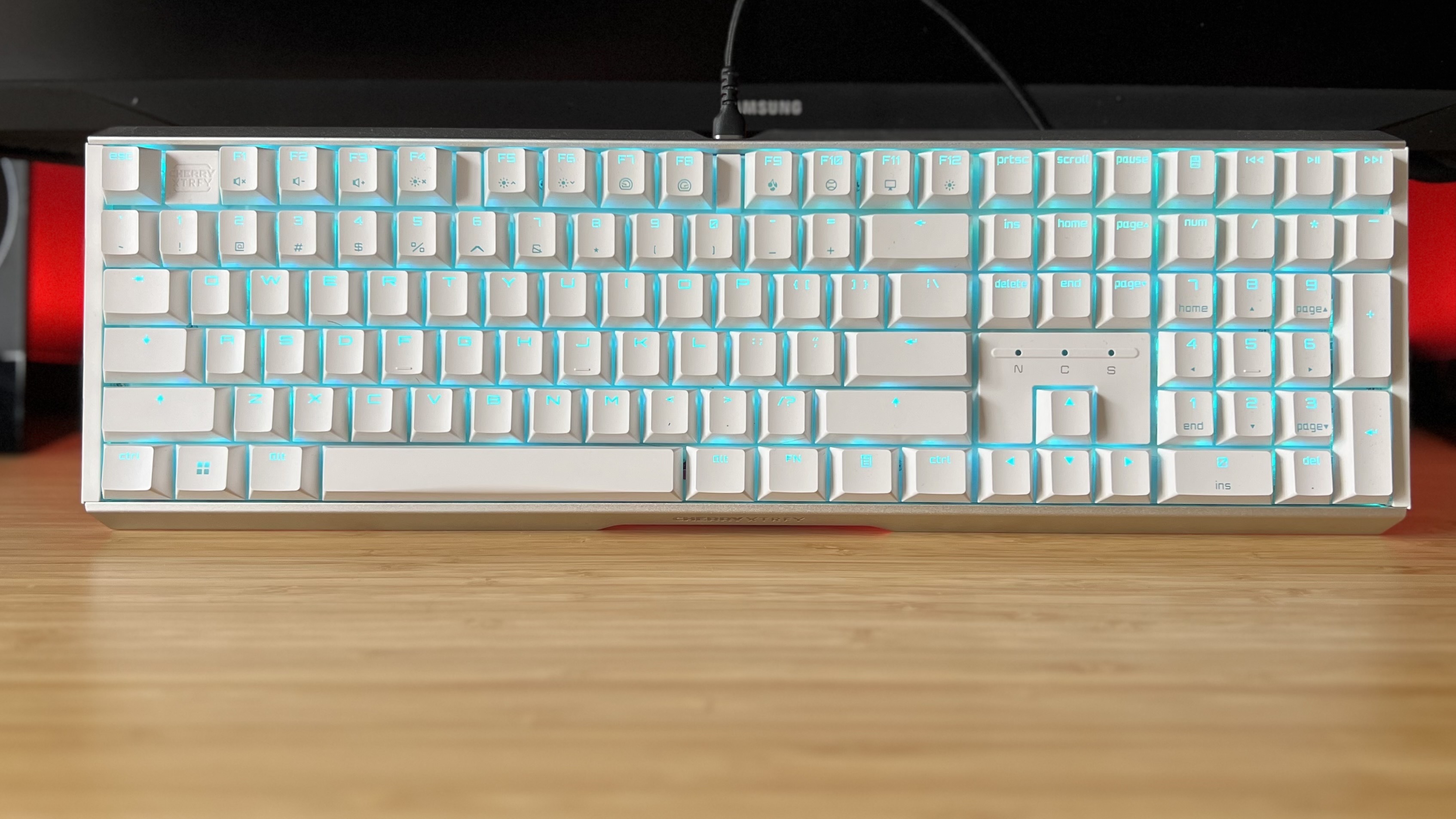GamesRadar+ Verdict
The Cherry MX 3.1 could be a cozy gamer's best friend, but if you're after something with dedicated high-speed gaming chops it can't quite keep up with mainstream flagships.
Pros
- +
Soft, comfortable typing experience
- +
Smooth switches
- +
Efficient software
- +
Low price compared to competition
Cons
- -
Fewer customization features
- -
Not enough elevation
- -
Less satisfying key feel
Why you can trust GamesRadar+
The Cherry MX 3.1 is a soft, velvety keyboard that pairs the brand's newer MX2A switches with a robust dampening system and smooth keycaps for a particularly pillowy typing feel. This is about smooth a gaming keyboard as you'll find, but whether or not that's a good thing depends on how precise you are and how fast you need to move across deck.
At $119.99 / £119.99, Cherry is undercutting a lot of the more expensive flagship decks on the markets. A full-sized Razer deck can cost you north of $200, but if you're after a softer typing feel and high-end mechanical switches Cherry's looking particularly strong right now. No, it doesn't feature the customizable switches of the best gaming keyboards on the market, but in the right hands it could well be a perfect fit.
Price | $119.99 / £119.99 |
Type | Mechanical |
Connection | Wired |
Size | Full |
Switches | Cherry MX2A |
Keycaps | ABS |
Media keys | Dedicated |
Wrist rest | None |
USB passthrough | None |
Design
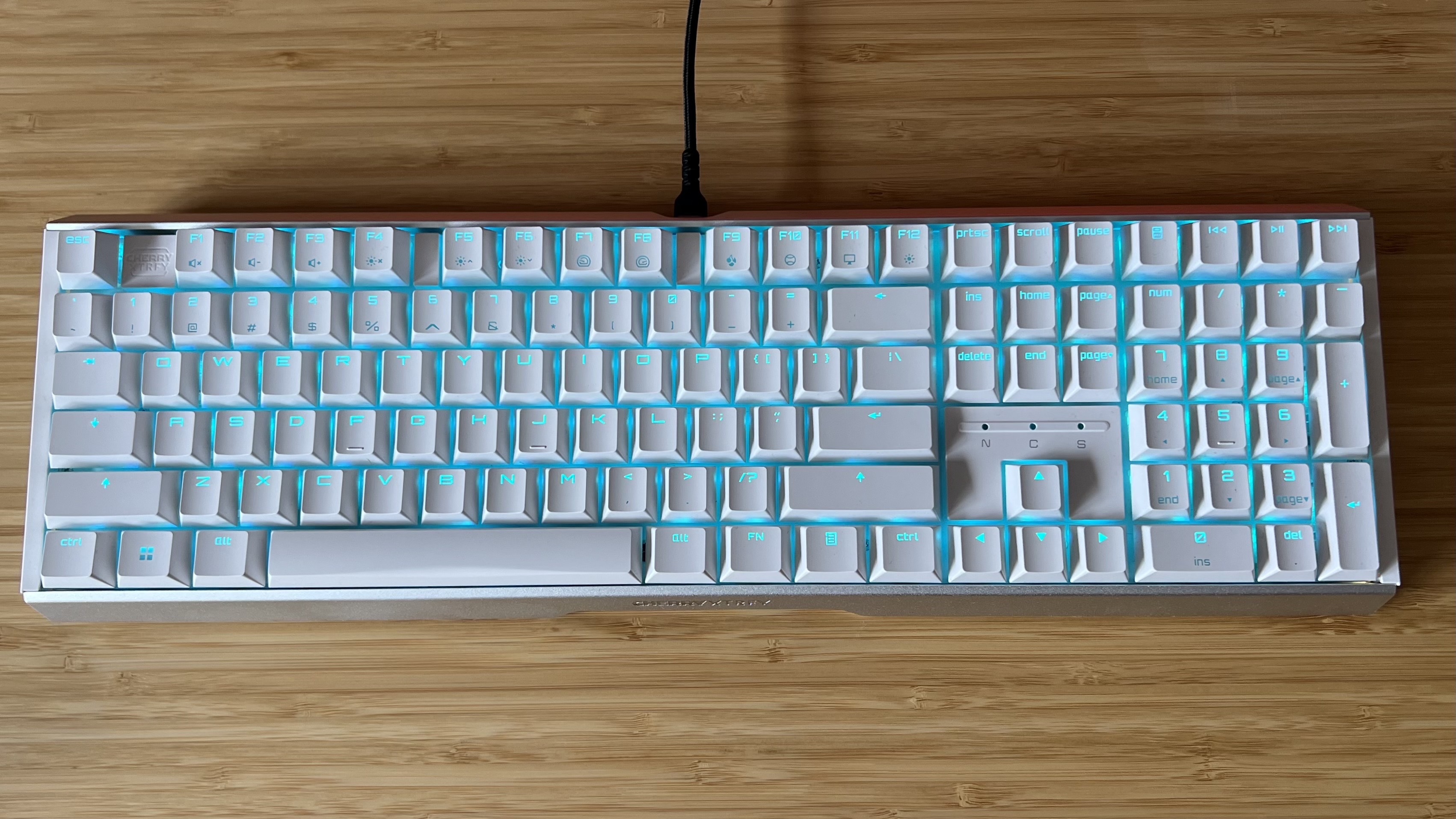
The Cherry MX 3.1 is simultaneously familiar and distinct in its design. The all-white top plate and keycaps are instantly recognizable from previous releases like the Cherry MX 8.2 and Cherry XTRFY K5V2 of yore. And yet, peering just underneath that is a silver aluminum chassis unlike anything I've seen on a gaming keyboard before.
A dappled metallic finish keeps things interesting, but not as visually striking as the windowed RGB lighting on each side. It doesn't exactly shine onto the surface below, so it never catches my eye when I'm using the keyboard face on. It's still a nifty look, though, and shows how far Cherry has double down on its looks after its fairly boring earlier releases.
The main deck plate and sides are all constructed from a solid plastic, with those silver panels at the top and bottom being aluminum. There's an oddity to this design, though, that helps the Cherry MX 3.1 stand out. A hollowed-out channel runs along the top and bottom of the deck via this metal plating. At first I thought this was a cable management runner, but it looks like it's purely aesthetic. It's a neat stand system, though I would have preferred built-in feet to the easily losable screws included in the box.
Build quality
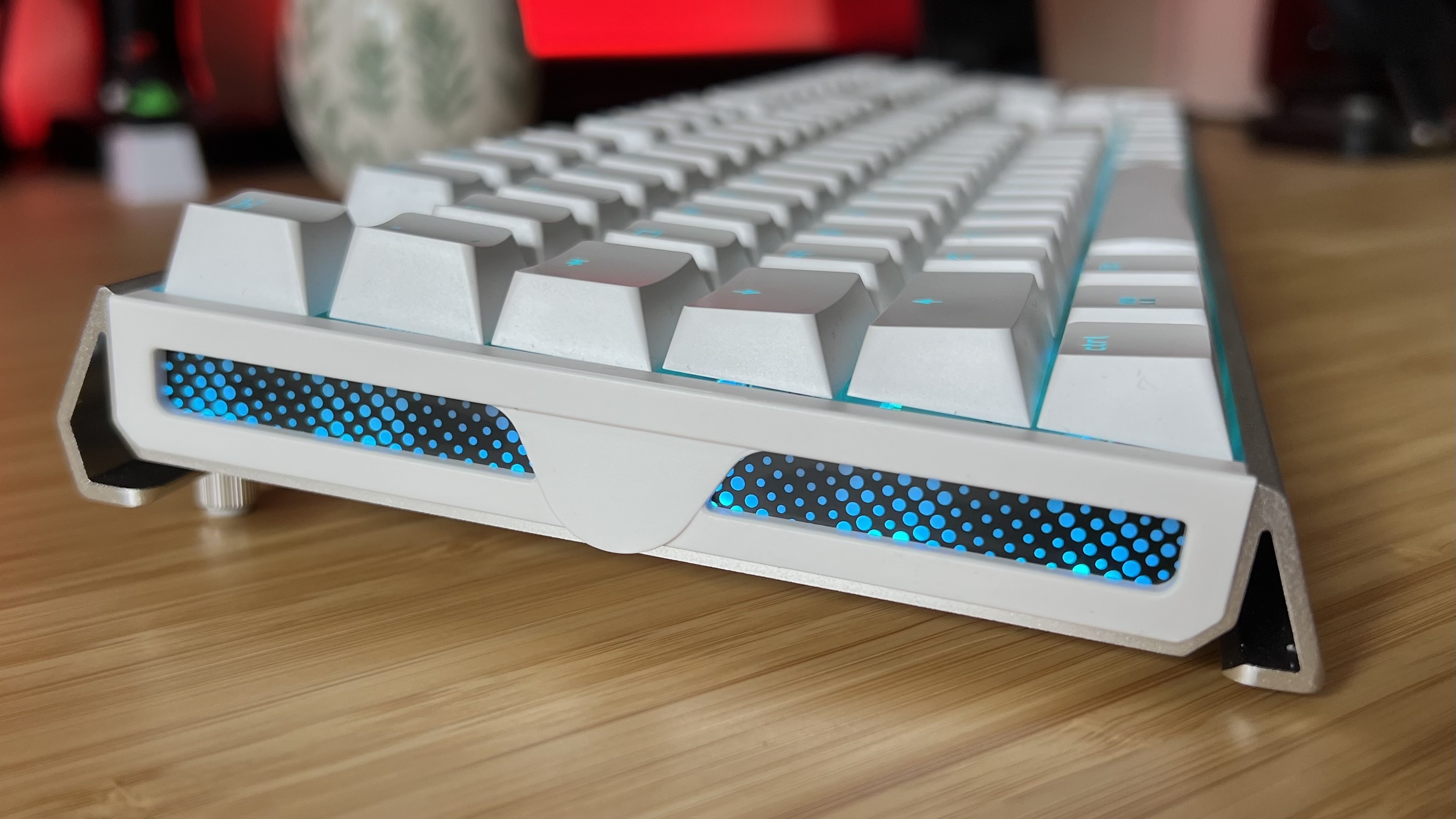
All of that makes for an interesting split between angular looks and soft feel. That plastic is pretty harshly cut on the sides, and the cut-out for the cable at the top is similarly boxy. However, the ABS keycaps, and switches overall, feel particularly smooth under the fingertips.
Everything is solidly put together, with a strong top plate only slightly yielding to pressure when I actively force it down. The aluminum chassis keeps everything sturdy on the desk. I'm not used to having a full-sized model in the center of my space, but it managed to survive all my mouse knocks without shifting out of place.
There's also a particularly satisfying amount of sound dampening going on inside the chassis. That means I experienced absolutely no switch pings or echoes during my testing, and every bottom-out feels cushioned with a bouncy spring back to full height.
Keycaps

I'm impressed with these caps, and that's not something I often find myself saying about ABS models. Rather than feeling shiny and oily, like the cheaper clackers on the Corsair K70 Pro TKL, they simply feel comfortable and smooth. I naturally prefer a more textured PBT, but this is a rare instance of ABS not feeling like a cheap-out.
Ergonomics
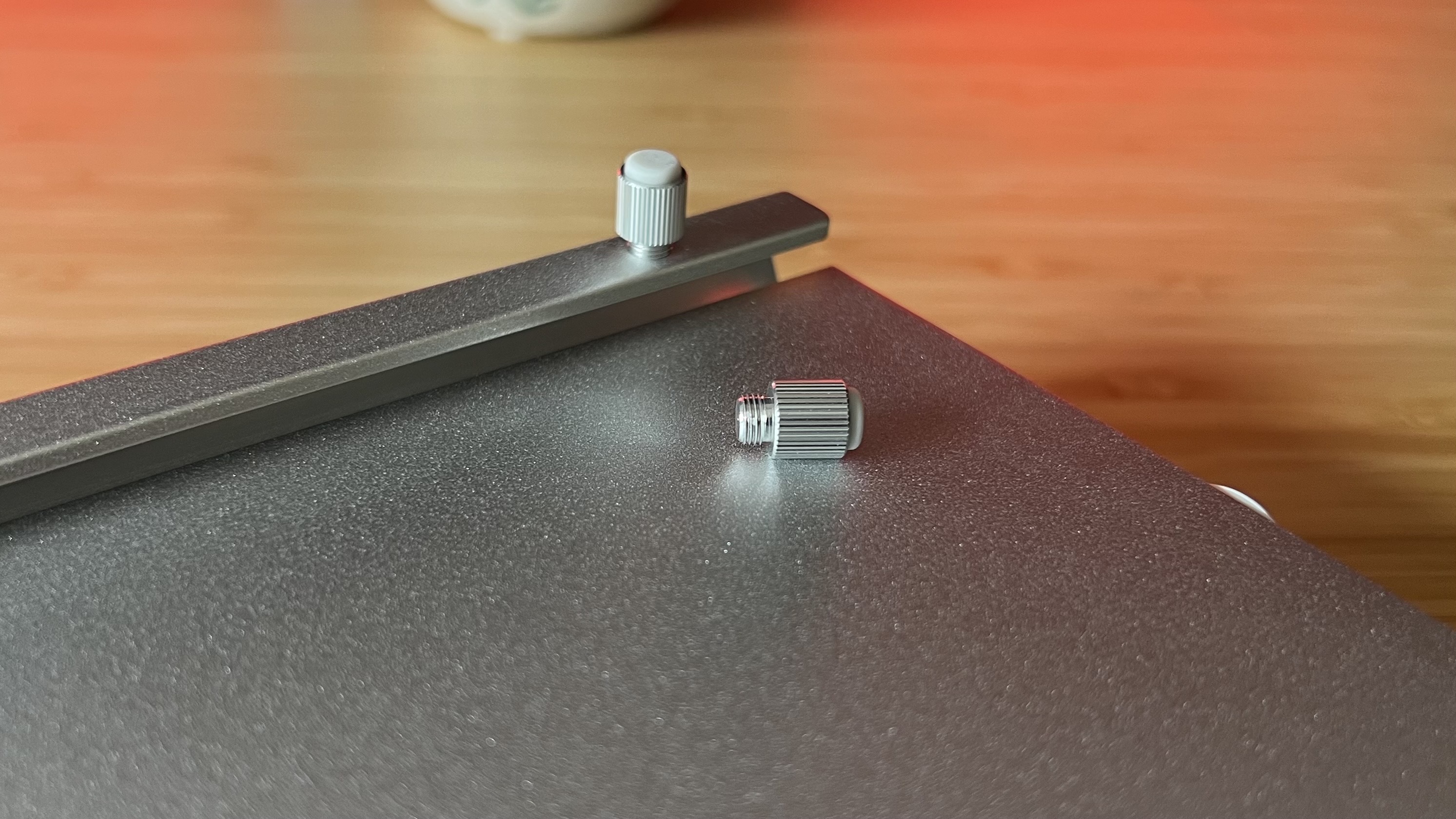
Unlike more compact 60%, 65%, or even TKL gaming keyboards, a full-sized model comes with its own ergonomic benefits. Keys are well-spaced on the Cherry MX 3.1, which means I'm not hunched over a small selection of clickers, but sitting comfortably with my shoulders nicely apart. I find that with smaller models, while they do allow for wider mouse movements, I'm often reaching too far over to the left to compensate.
Rather than using inbuilt folding feet for elevation, however, Cherry has opted for a set of two screw-in toppers. They're installed by plucking the existing covers out of the keyboard and simply twirling the taller feet in. That does leave you with two extra parts, small enough to lose pretty much instantly.
I'm not a fan of this method. While the feet themselves are sturdy, and the screw design means they don't fall out from under the keyboard when pushed up and down the desk (like regular hinge models), they don't provide as much elevation as I've seen in other decks. There's also only one height option, whereas most models offer two.
Switches
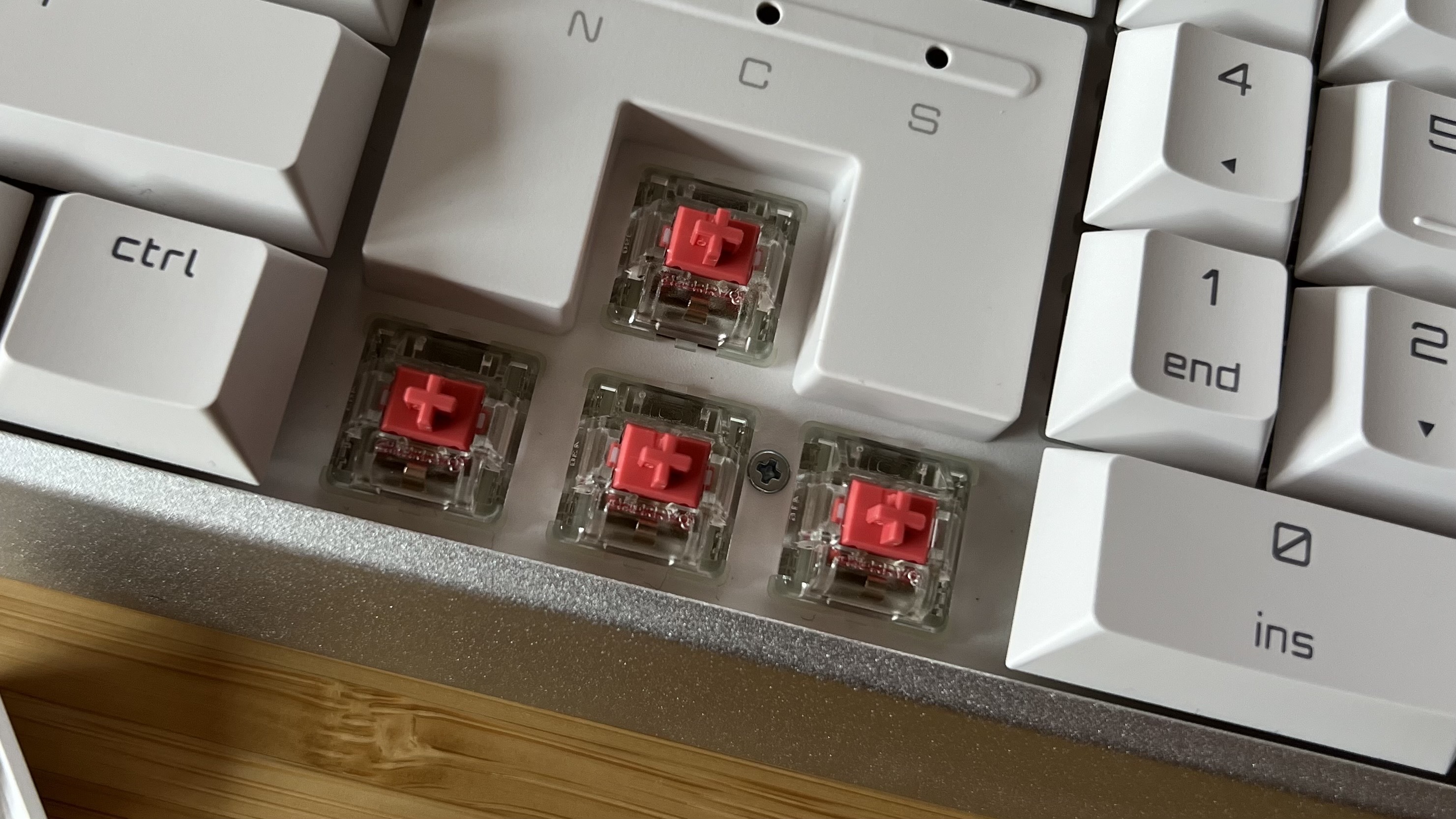
The deck I've been testing uses Cherry MX2A Silent Red clickers, your classic red linears with a slightly a slightly shorter 1.9mm of pre-travel and 3.7mm total travel (compared to the previous generation MX Reds).
That means they're swift, soft, and smooth, with a relaxed feel that lends itself well to both typing and gameplay. This is the second generation of Cherry switches, offering factory lubrication and contactless motion to avoid the scratchy feel that plagued many before them, while also moving over to a new spring design that maintains uniformity in rapid keypresses.
That's what Cherry's said at least. I've noticed significantly less rattle and scratching in my time with these clickers, and a nicely energetic return to full height as well. While the landing can sometimes err on the side of mushy, as is common with shorter linears, it's a comfortable experience if you're opting for a quieter switch.
I still cannot, for the life of me, work out why Cherry's keyboards aren't hot-swappable considering the brand is one of the biggest manufacturers of individual switches on the market - but there we go.
Software
The Cherry MX 3.1 relies on the Cherry Utility Software for basic key mapping and RGB settings. This is a lightweight program with no ads, no heavy CPU loads (accounting for 0.1% during my usage), and simple, streamlined access to controls. It's refreshing after wading through SteelSeries' marketing or Razer's nested menus, though with simple mechanical switches and no wireless connections there's not a whole lot you can do with it.
Each key is programmed through its own 'Action', a setup that adds an extra step over others but is easy enough to work through. From there, you can create a macro (though you can't save them to use across additional keys), replace the input, select a PC function or input custom text. Everything is saved across a series of profiles, listed on the left.
RGB settings are clean and simple, offering a range of different presets for both the keys and side lighting areas as well as a slider for speed. Per-key effects are also available.
There's no ability to tie your profiles to specific games like you'll find in most brands' programs and no SOCD settings to configure either.
Controls
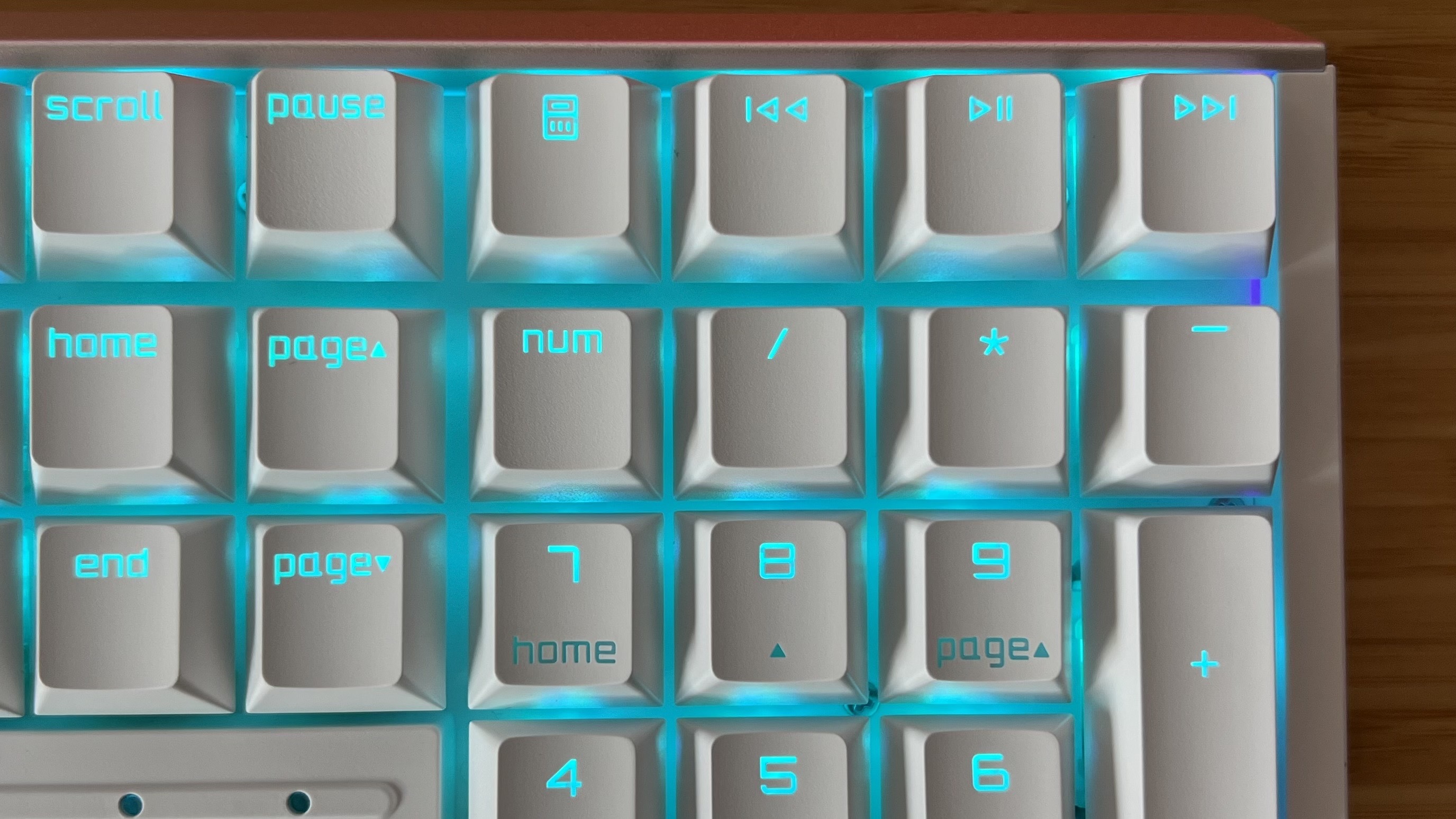
Full-sized decks are rarely lacking in onboard controls, and the Cherry MX 3.1 has you covered for all the basics. You've got every key you'd expect from a full plank here, as well as dedicated media playback options and additional functions up top. This is where you'll find the volume settings - unfortunately, Cherry doesn't include a dedicated volume roller or control dial like many others. Instead, that top-bezel space is shaved off and you'll be hitting that Fn key to change your settings on the fly (should you not wish to remap in the software).
Connection
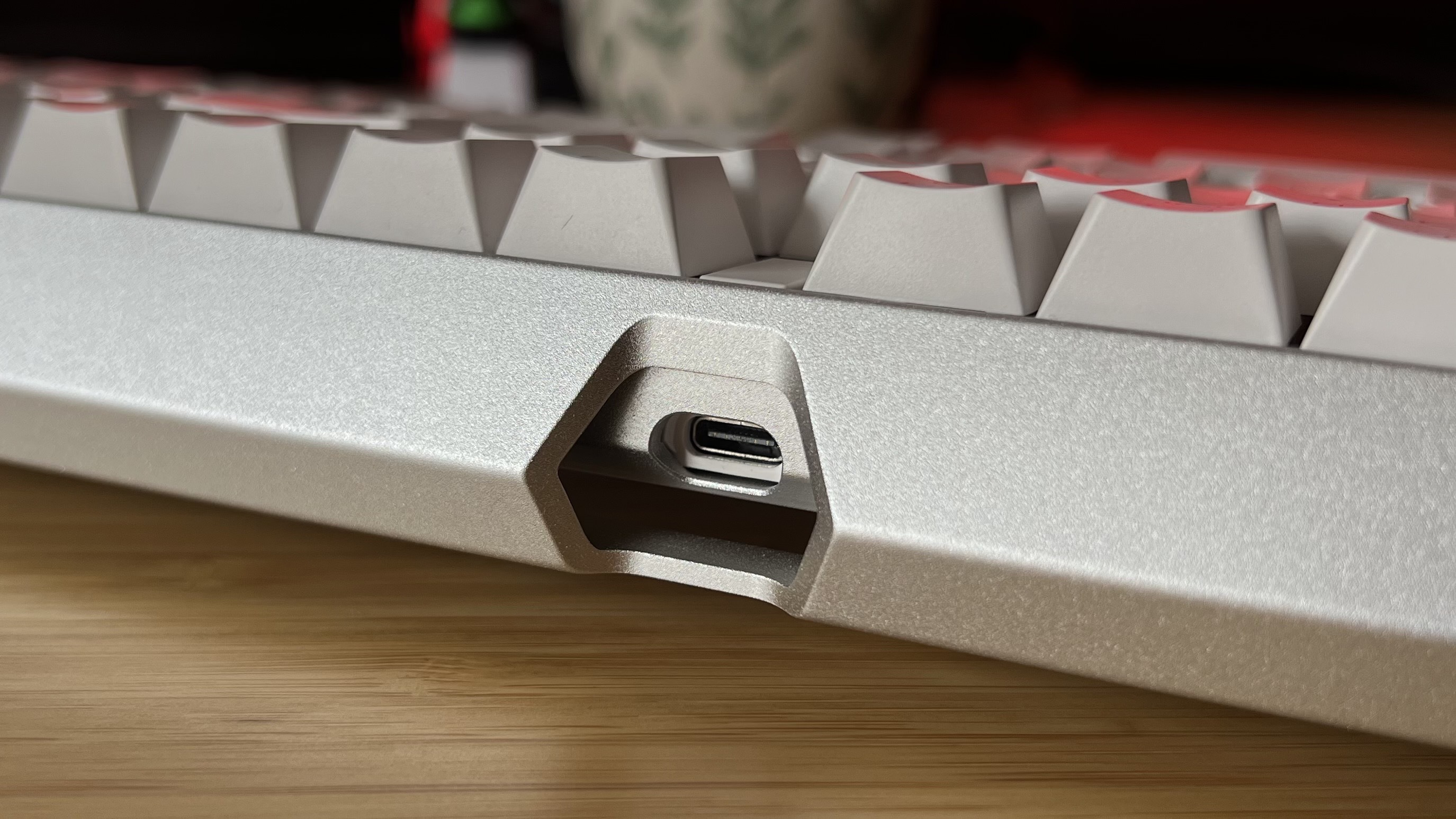
This is a fully wired affair, with a USB-C port located inside of a particularly angular crevice in the top center of the deck. It's a simple plug and play deck, with a 1,000Hz polling rate and a braided cable supplied. It would be tough to find a full-sized wireless deck for a similar price point, and they're rare these days.
A wireless connection is great for keeping cables off your desk, yes, but it's primary benefit is portability. There aren't many players lugging a full-sized keyboard around with them these days, which is why you'll find more 2.4GHz and Bluetooth connections in more compact models.
Typing
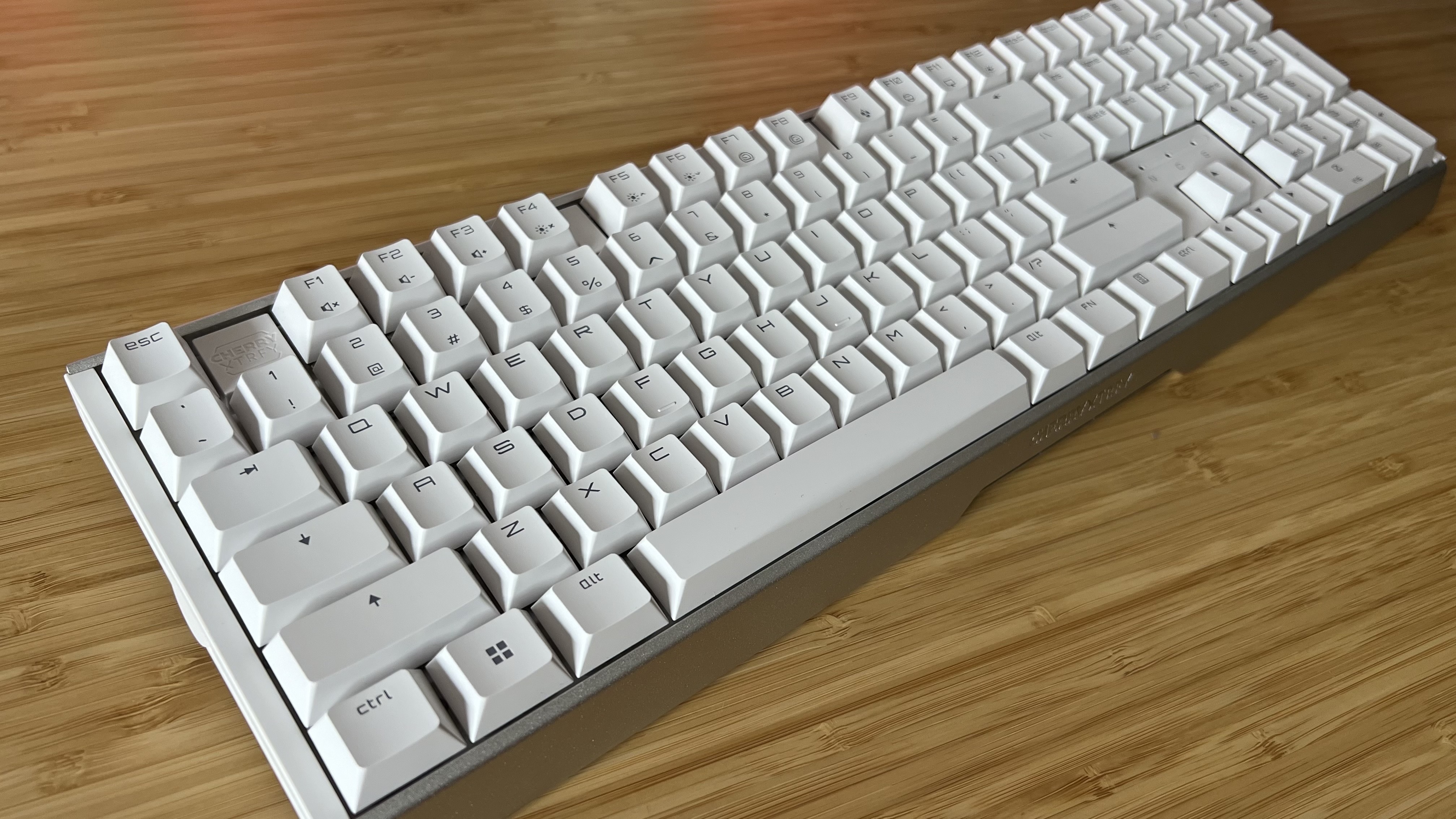
This is a particularly comfortable typing experience, but not the most satisfying. The softer feel means less strain on the fingers over a long period of time but a less tactile thunk to each key overall. I typed for about 13 hours in one stretch during my testing, and never felt the fatigue I would have on something stiffer like the Endgame Gear KB65HE or SteelSeries Apex Pro TKL Gen 3, but I did miss that more robust switch feel at the time.
I averaged a typing speed of 94 WPM with the Cherry MX 3.1 at the helm, running at 93% accuracy. That's slightly towards the lower end of my usual scores, with precision taking the larger hit.
The comparison below takes a spread of the mechanical gaming keyboards at the top of their categories as well as a range of Cherry alternatives and the Ducky One X (a similar-feeling full-sized deck, with inductive switches). Most notably, the Cherry MX 3.1 comes at the same speed as the MX 8.2, but with a reduced accuracy.
Gaming
This is about as simple as gaming keyboards come with no adjustable switches, debounce settings, or game mode features to play with. Of course, you're still getting the n-key rollover you'd expect from a deck in 2025, but that's about it.
It's certainly not unplayable, but considering there are cheaper wired keyboards out there busting with more gaming-specific personalization options it's not the best value experience on the market. This feels more like a cozy setup item than a companion to enhance your gameplay experience.
Still, I was able to strafe and glide like the rest of them in more competitive games, with easy macro and keybinding options in the software and snappy inputs registering at a tap. The full-size design isn't the best for FPS titles, especially if you want to fine-tune your mouse's sensitivity for more precise controls (and therefore wider sweeps).
However, I was able to stay nimble in single-player adventures like Indiana Jones and the Great Circle while still enjoying a wide enough key spacing to reliably hit additional commands without any accidental presses.
Should you buy the Cherry MX 3.1?
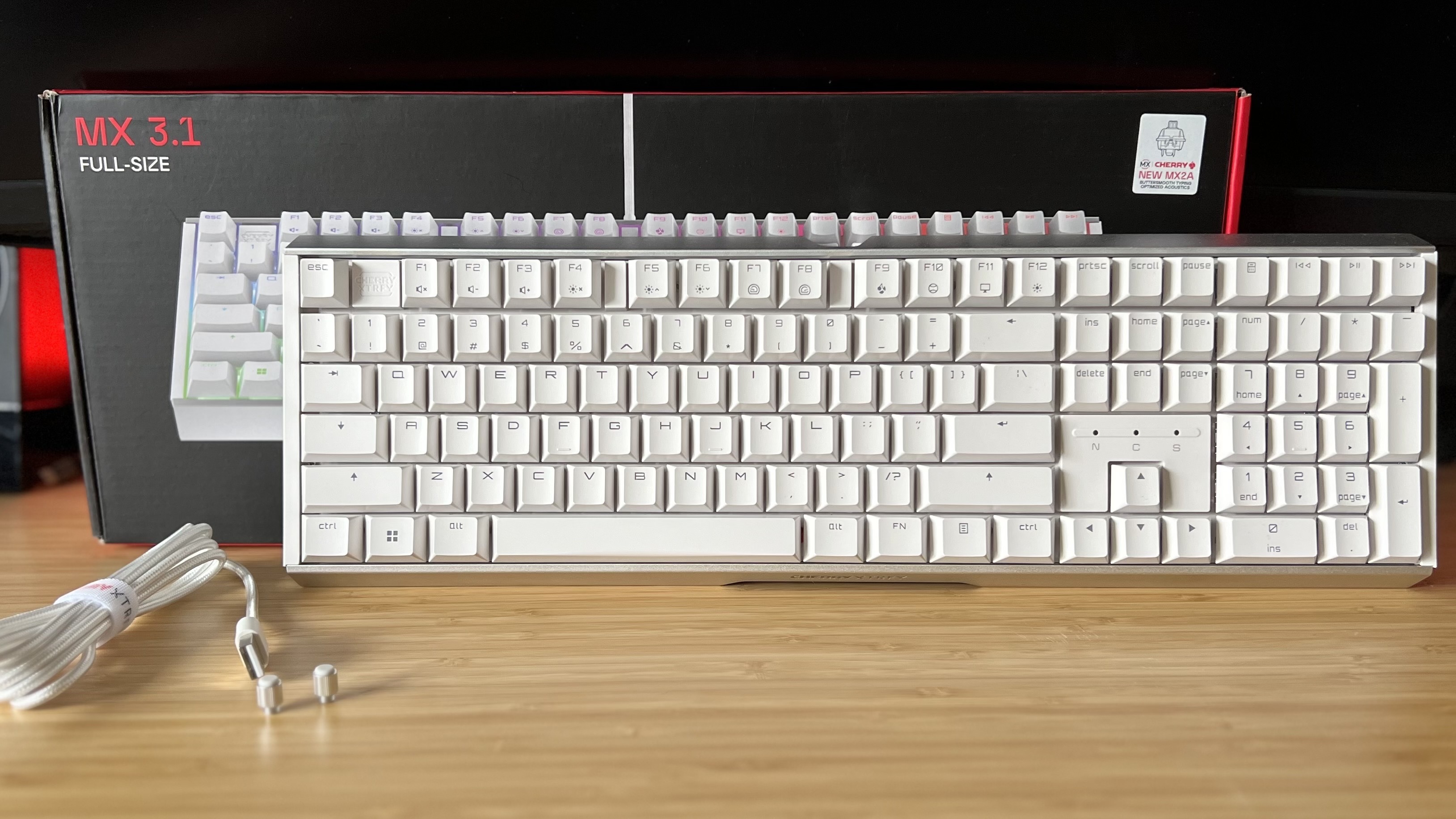
If you use your keyboard for work 80% of the time and for play 20% of the time, prefer a softer switch feel, and don't want keyboard clack ruining your audio, the Cherry MX 3.1 could well be a wise purchase. It's not got the chops of more substantial gaming decks like the $219.99 SteelSeries Apex Pro TKL Gen 3 or $179 Ducky One X (for a full-sized comparison), but it ticks along in-game nicely with a basic set of keybinding and RGB lighting software controls at your disposal.
If you need a performance-focused keyboard for more competitive endeavors, I'd recommend something that prioritizes speed and tactility over additional controls and comfort. The Logitech G Pro X TKL Rapid is excellent value, packing in Hall effect switches and a set of slick PBT keycaps at $169.99, or the Corsair K65 Plus Wireless at $159.99.
That said, Cherry is occupying a particularly lucrative price point here. There aren't many gaming keyboards nearing that $100 threshold, and even fewer doing so with a full number pad attached.
Speed | 4/5 |
Customization | 2/5 |
Typing feel | 3/5 |
Portability | 1/5 |
Comfort | 4/5 |
Controls | 4/5 |
How I tested the Cherry MX 3.1
I used the Cherry MX 3.1 across both work and play for one week, while also comparing directly against the Ducky One X and Cherry MX 8.2. In that time I primarily played Indiana Jones and the Great Circle and Fallout 4, while also testing in Apex Legends specifically. I also performed three typing tests, taking the average of all three as my final score for comparison. For more information on how we test gaming keyboards, check out the full GamesRadar+ Hardware Policy.
If you need to cut the cord, check out the best wireless gaming keyboards on the market, or take a look at the best hot-swappable keyboards available for more switch options. I'm also rounding up the best membrane keyboards for cheaper alternatives as well.

Managing Editor of Hardware at GamesRadar+, I originally landed in hardware at our sister site TechRadar before moving over to GamesRadar. In between, I've written for Tom’s Guide, Wireframe, The Indie Game Website and That Video Game Blog, covering everything from the PS5 launch to the Apple Pencil. Now, i'm focused on Nintendo Switch, gaming laptops (and the keyboards, headsets and mice that come with them), PS5, and trying to find the perfect projector.
You must confirm your public display name before commenting
Please logout and then login again, you will then be prompted to enter your display name.
